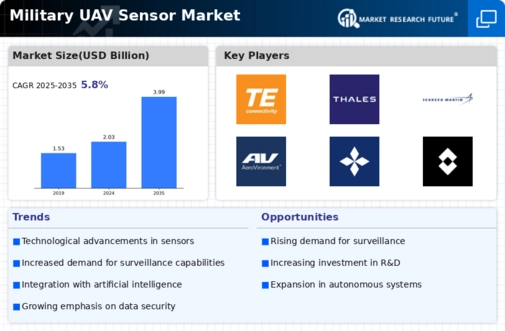-
Executive Summary
-
Market Attractiveness Analysis
- Global Military UAV Sensor Market, by Application
- Global Military UAV Sensor Market, by Technology Type
- Global Military UAV Sensor Market, by UAV Type
- Global Military UAV Sensor Market, by Platform
- Global Military UAV Sensor Market, by Region
-
Scope of the Report
-
Market Definition
-
Scope of the Study
- Definition
- Research Objective
- Assumptions
- Limitations
-
Research Process
- Primary Research
- Secondary Research
-
Market Size Estimation
-
Forecast Model
-
Market Landscape
-
Porter’s Five Forces Analysis
- Threat of New Entrants
- Bargaining Power of Buyers
- Threat of Substitutes
- Segment Rivalry
- Bargaining Power of Buyers
-
Value Chain/Supply Chain Analysis
-
Market Dynamics
-
Introduction
-
Market Drivers
-
Market Restraints
-
Market Opportunities
-
Market Trends
-
Military UAV Sensors Market, by UAV Type
-
Introduction
-
High-Altitude Long Endurance (HALE)
- Market Estimates & Forecast, 2020–2027
- Market Estimates & Forecast, by Region, 2020–2027
-
Medium-Altitude Long Endurance (MALE)
- Market Estimates & Forecast, 2020–2027
- Market Estimates & Forecast, by Region, 2020–2027
-
Tactical
- Market Estimates & Forecast, 2020–2027
- Market Estimates & Forecast, by Region, 2020–2027
-
Small
- Market Estimates & Forecast, 2020–2027
- Market Estimates & Forecast, by Region, 2020–2027
-
Military UAV Sensors Market, by Platform
-
Introduction
-
Radar Sensor
- Market Estimates & Forecast, 2020–2027
- Market Estimates & Forecast, by Region, 2020–2027
-
Image Sensor
- Market Estimates & Forecast, 2020–2027
- Market Estimates & Forecast, by Region, 2020–2027
-
Motion & Position Sensor
- Market Estimates & Forecast, 2020–2027
- Market Estimates & Forecast, by Region, 2020–2027
-
Others
- Market Estimates & Forecast, 2020–2027
- Market Estimates & Forecast, by Region, 2020–2027
-
Military UAV Sensors Market, by Technology Type
-
Introduction
-
Complementary Metal Oxide Semiconductor (CMOS)
- Market Estimates & Forecast, 2020–2027
- Market Estimates & Forecast, by Region, 2020–2027
-
Micro-Electro-Mechanical Semiconductor (MEMS)
- Market Estimates & Forecast, 2020–2027
- Market Estimates & Forecast, by Region, 2020–2027
-
Nano-Electro-Mechanical Semiconductor (NEMS)
- Market Estimates & Forecast, 2020–2027
- Market Estimates & Forecast, by Region, 2020–2027
-
Others
- Market Estimates & Forecast, 2020–2027
- Market Estimates & Forecast, by Region, 2020–2027
-
Military UAV Sensors Market, by Application
-
Introduction
-
Collision Avoidance
- Market Estimates & Forecast, 2020–2027
- Market Estimates & Forecast, by Region, 2020–2027
-
Navigation
- Market Estimates & Forecast, 2020–2027
- Market Estimates & Forecast, by Region, 2020–2027
-
3D Scanner
- Market Estimates & Forecast, 2020–2027
- Market Estimates & Forecast, by Region, 2020–2027
-
Data Acquisition
- Market Estimates & Forecast, 2020–2027
- Market Estimates & Forecast, by Region, 2020–2027
-
LIDAR
- Market Estimates & Forecast, 2020–2027
- Market Estimates & Forecast, by Region, 2020–2027
-
Others
- Market Estimates & Forecast, 2020–2027
- Market Estimates & Forecast, by Region, 2020–2027
-
Military UAV Sensors Market, by Region
-
Introduction
-
North America
- Market Estimates & Forecast, 2020–2027
- Market Estimates & Forecast, by UAV Type, 2020–2027
- Market Estimates & Forecast, by Platform, 2020–2027
- Market Estimates & Forecast, by Technology Type, 2020–2027
- Market Estimates & Forecast, by Application, 2020–2027
- U.S.
- Canada
-
Europe
- Market Estimates & Forecast, 2020–2027
- Market Estimates & Forecast, by UAV Type, 2020–2027
- Market Estimates & Forecast, by Platform, 2020–2027
- Market Estimates & Forecast, by Technology Type, 2020–2027
- Market Estimates & Forecast, by Application, 2020–2027
- UK
- Germany
- France
- Russia
- Rest of Europe
-
Asia-Pacific
- Market Estimates & Forecast, 2020–2027
- Market Estimates & Forecast, by UAV Type, 2020–2027
- Market Estimates & Forecast, by Platform, 2020–2027
- Market Estimates & Forecast, by Technology Type, 2020–2027
- Market Estimates & Forecast, by Application, 2020–2027
- China
- Japan
- India
- Rest of Asia-Pacific
-
Middle East & Africa
- Market Estimates & Forecast, 2020–2027
- Market Estimates & Forecast, by UAV Type, 2020–2027
- Market Estimates & Forecast, by Platform, 2020–2027
- Market Estimates & Forecast, by Technology Type, 2020–2027
- Market Estimates & Forecast, by Application, 2020–2027
-
Latin America
- Market Estimates & Forecast, 2020–2027
- Market Estimates & Forecast, by UAV Type, 2020–2027
- Market Estimates & Forecast, by Platform, 2020–2027
- Market Estimates & Forecast, by Technology Type, 2020–2027
- Market Estimates & Forecast, by Application, 2020–2027
-
Competitive Landscape
-
Company Profile
-
TE Connectivity
- Company Overview
- Products/Services Offered
- Financial Overview
- Key Developments
- Key Strategies
- SWOT Analysis
-
Raytheon Company
- Company Overview
- Products/Services Offered
- Financial Overview
- Key Developments
- Key Strategies
- SWOT Analysis
-
Thales Group
- Company Overview
- Products/Services Offered
- Financial Overview
- Key Developments
- Key Strategies
- SWOT Analysis
-
Lockheed Martin
- Company Overview
- Products/Services Offered
- Financial Overview
- Key Developments
- Key Strategies
- SWOT Analysis
-
AeroVironment
- Company Overview
- Products/Services Offered
- Financial Overview
- Key Developments
- Key Strategies
- SWOT Analysis
-
General Atomics
- Company Overview
- Products/Services Offered
- Financial Overview
- Key Developments
- Key Strategies
- SWOT Analysis
-
FLIR Systems
- Company Overview
- Products/Services Offered
- Financial Overview
- Key Developments
- Key Strategies
- SWOT Analysis
-
Elbit Systems
- Company Overview
- Products/Services Offered
- Financial Overview
- Key Developments
- Key Strategies
- SWOT Analysis
-
Kratos Defense & Security Solutions
- Company Overview
- Products/Services Offered
- Financial Overview
- Key Developments
- Key Strategies
- SWOT Analysis
-
Safran Electronics & Defense
- Company Overview
- Products/Services Offered
- Financial Overview
- Key Developments
- Key Strategies
- SWOT Analysis
-
Northrop Grumman Corporation
- Company Overview
- Products/Services Offered
- Financial Overview
- Key Developments
- Key Strategies
- SWOT Analysis
-
Honeywell International Inc.
- Company Overview
- Products/Services Offered
- Financial Overview
- Key Developments
- Key Strategies
- SWOT Analysis
-
Appendix
-
References
-
Related Reports
-
List of Abbreviations
-
Industry Insights
-
Note: This table of contents is tentative and subject to change as the research progresses.
-
List of Tables
-
Global Military UAV Sensor Market, by Region, 2020–2027
-
North America Military UAV Sensor Market, by Country, 2020–2027
-
Europe Military UAV Sensor Market, by Country, 2020–2027
-
Asia-Pacific Military UAV Sensor Market, by Country, 2020–2027
-
Middle East & Africa Military UAV Sensor Market, by Country, 2020–2027
-
Latin America Military UAV Sensor Market, by Country, 2020–2027
-
Global Military UAV Sensor Market, by Region, 2020–2027
-
Global Military UAV Sensor Market, by Technology Type, 2020–2027
-
Global Military UAV Sensor Market, by UAV Type, 2020–2027
-
Global Military UAV Sensor Market, by Platform, 2020–2027
-
Global Military UAV Sensor Market, by Application, 2020–2027
-
North America: Military UAV Sensor Market, by Country, 2020–2027
-
North America: Military UAV Sensor Market, by Technology Type, 2020–2027
-
North America: Military UAV Sensor Market, by UAV Type, 2020–2027
-
North America: Military UAV Sensor Market, by Platform, 2020–2027
-
North America: Military UAV Sensor Market, by Application, 2020–2027
-
Europe: Military UAV Sensor Market, by Country, 2020–2027
-
Europe: Military UAV Sensor Market, by Technology Type, 2020–2027
-
Europe: Military UAV Sensor Market, by UAV Type, 2020–2027
-
Europe: Military UAV Sensor Market, by Platform, 2020–2027
-
Europe: Military UAV Sensor Market, by Application, 2020–2027
-
Asia-Pacific: Military UAV Sensor Market, by Country, 2020–2027
-
Asia-Pacific: Military UAV Sensor Market, by Technology Type, 2020–2027
-
Asia-Pacific: Military UAV Sensor Market, by UAV Type, 2020–2027
-
Asia-Pacific: Military UAV Sensor Market, by Platform, 2020–2027
-
Asia-Pacific: Military UAV Sensor Market, by Application, 2020–2027
-
Middle East & Africa: Military UAV Sensor Market, by Region, 2020–2027
-
Middle East & Africa: Military UAV Sensor Market, by Technology Type, 2020–2027
-
Middle East & Africa: Military UAV Sensor Market, by UAV Type, 2020–2027
-
Middle East & Africa: Military UAV Sensor Market, by Platform, 2020–2027
-
Middle East & Africa: Military UAV Sensor Market, by Application, 2020–2027
-
Latin America: Military UAV Sensor Market, by Region, 2020–2027
-
Latin America: Military UAV Sensor Market, by Technology Type, 2020–2027
-
Latin America: Military UAV Sensor Market, by UAV Type, 2020–2027
-
Latin America: Military UAV Sensor Market, by Platform, 2020–2027
-
Latin America: Military UAV Sensor Market, by Application, 2020–2027
-
List of Figures
-
Research Process of MRFR
-
Top-Down and Bottom-Up Approaches
-
Market Dynamics
-
Impact Analysis: Market Drivers
-
Impact Analysis: Market Restraints
-
Porter's Five Forces Analysis
-
Value Chain Analysis
-
Global Military UAV Sensor Market Share, by Technology Type, 2020 (%)
-
Global Military UAV Sensor Market, by Technology Type, 2020–2027 (USD Million)
-
Global Military UAV Sensor Market Share, by UAV Type, 2020 (%)
-
Global Military UAV Sensor Market, by UAV Type, 2020–2027 (USD Million)
-
Global Military UAV Sensor Market Share, by Platform, 2020 (%)
-
Global Military UAV Sensor Market, by Platform, 2020–2027 (USD Million)
-
Global Military UAV Sensor Market Share, by Application, 2020 (%)
-
Global Military UAV Sensor Market, by Application, 2020–2027 (USD Million)
-
Global Military UAV Sensor Market Share (%), by Region, 2020
-
Global Military UAV Sensor Market, by Region, 2020–2027 (USD Million)
-
North America: Military UAV Sensor Market Share (%), 2020
-
North America: Military UAV Sensor Market by Country, 2020–2027 (USD Million)
-
Europe: Military UAV Sensor Market Share (%), 2020
-
Europe: Military UAV Sensor Market by Country, 2020–2027 (USD Million)
-
Asia-Pacific: Military UAV Sensor Market Share (%), 2020
-
Asia-Pacific: Military UAV Sensor Market by Country, 2020–2027 (USD Million)
-
Middle East & Africa Military UAV Sensor Market Share (%), 2020
-
Middle East & Africa Military UAV Sensor Market by Region, 2020–2027 (USD Million)
-
Latin America Military UAV Sensor Market Share (%), 2020
-
Latin America Military UAV Sensor Market by Region, 2020–2027 (USD Million)

















Leave a Comment